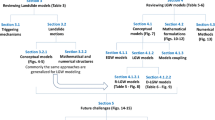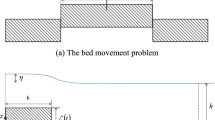Abstract
In this study, the method of lines (MOL) has been applied to solve two-dimensional vertically integrated shallow water equations in Cartesian coordinates for the prediction of water levels due to a storm surge along the coast of Bangladesh. In doing so, the partial derivatives with respect to the space variables were discretized by the finite difference (central) method to obtain a system of ordinary differential equations (ODEs) with time as independent variable. The classical fourth-order Runge–Kutta method was used to solve the obtained system of the ODEs. We used a nested finite difference scheme, where a high resolution fine grid model (FGM) capable of incorporating all major islands along the coastal region of Bangladesh was nested into a coarse grid model (CGM) covering up to 15°N latitude of the Bay of Bengal. The boundaries of the coast and islands were approximated through proper stair step. Appropriate tidal condition over the model domain was generated by forcing the sea level to be oscillatory with the constituent M 2 along the southern open boundary of the CGM omitting wind stress. Along the northeast corner of the FGM, the Meghna River discharge was taken into account. The developed model was applied to estimate water levels along the coast of Bangladesh due to the interaction of tide and surge associated with the April 1991 storm. We also computed our results employing the standard finite difference method (FDM). Simulated results show the MOL performs well in comparison with the FDM with regard to CPU time and stability, and ensures conformity with observations.







Similar content being viewed by others
References
Ali A (1979) Storm surges in the Bay of Bengal and some related problems. PhD thesis, University of Reading, England
As-Salek JA (1998) Coastal trapping and funneling effects on storm surges in the Meghna estuary in relation to cyclones hitting Noakhali–Cox’s Bazar coast of Bangladesh. J Phys Oceanogr 28:227–249
Bajo M, Zampato L, Umgiesser G, Cucco A, Canestrelli P (2007) A finite element operational model for storm surge prediction in Venice. Estuar Coast Shelf Sci 75:236–249
Cash JR (2005) Efficient time integrators in the numerical method of lines. J Comput Appl Math 183:259–274
Debsarma SK (2009) Simulations of storm surges in the Bay of Bengal. Mar Geod 32:178–198
Dube SK, Chittibabu P, Sinha PC, Rao AD (2004) Numerical modelling of storm surge in the head Bay of Bengal using location specific model. Nat Hazards 31:437–453
Dube SK, Jain I, Rao AD, Murty TS (2009) Storm surge modelling for the Bay of Bengal and Arabian Sea. Nat Hazards 51:3–27
Flather RA (1994) A storm surge prediction model for the northern Bay of Bengal with application to the cyclone disaster in April 1991. J Phys Oceanogr 24:172–190
Flather RA (2000) Existing operational oceanography. Coast Eng 41:13–40
Ismail AIM, Karim F, Roy GD, Meah MA (2007) Numerical modelling of tsunami via the method of lines. WASET 32:177–185
Jain SK, Agarwal PK, Singh VP (2007) Hydrology and water resources of India. Springer, Dordrecht
Jelesnianski CP (1965) A numerical calculation of storm tides induced by a tropical storm impinging on a continental shelf. Mon Weather Rev 93:343–358
Johns B, Ali A (1980) The numerical modeling of storm surges in the Bay of Bengal. Q J R Meteor Soc 106:1–18
Johns B, Rao AD, Dube SK, Sinha PC (1985) Numerical modelling of tide-surge interaction in the Bay of Bengal. Philos Trans R Soc Lond B 313:507–535
Joseph A, Prabhudesai RG, Mehra P, Kumar VS, Radhakrishnan KV, Kumar V, Kumar KA, Agarwadekar Y, Bhat UG, Ryan L, Rivankar P, Viegas B (2011) Response of west India coastal waters and Kavaratti lagoon to the November-2009 tropical cyclone Phyan. Nat Hazards 57:293–312
Khalil GM (1993) The catastrophic cyclone of April 1991: its impact on the economy of Bangladesh. Nat Hazards 8:263–281
Meah MA, Karim MF, Ismail AIM (2010) A boundary fitted curvilinear shallow water model for computing storm surge along the coast Bangladesh. Far East J App Math 41:1–20
Milliman JD (1991) Flux and fate of fluvial sediment and water in coastal seas. In: Mantoura RFC, Martin JM, Wollast R (eds) Ocean margin processes in global change. Wiley, Chichester, pp 69–89
Mills DA (1985) A numerical hydrodynamic model applied to tidal dynamics in the Dampier Archipelago. Bulletin no. 190, Department of Conservation and Environment, Western Australia
Paul GC, Ismail AIM (2012a) Numerical modeling of storm surges with air bubble effects along the coast of Bangladesh. Ocean Eng 42:188–194
Paul GC, Ismail AIM (2012b) Tide–surge interaction model including air bubble effects for the coast of Bangladesh. J Frankl Inst 349:2530–2546
Paul GC, Ismail AIM (2013) Contribution of offshore islands in the prediction of water levels due to tide–surge interaction for the coastal region of Bangladesh. Nat Hazards 65:13–25
Rahman MM, Paul GC, Hoque A (2013) Nested numerical scheme in a polar coordinate shallow water model for the coast of Bangladesh. J Coast Conserve 17:37–47
Roy GD (1995) Estimation of expected maximum possible water level along the Meghna estuary using a tide and surge interaction model. Environ Int 21:671–677
Roy GD (1999) Inclusion of off-shore islands in a transformed coordinate shallow water model along the coast of Bangladesh. Environ Int 25:67–74
Roy GD, Kabir ABMH, Mandal MM, Haque MZ (1999) Polar coordinates shallow water storm surge model for the coast of Bangladesh. Dynam Atmos Oceans 29:397–413
Sadiku MNO, Gorcia RC (2000) Method of lines solutions of axisymmetric problems. In: Southeastcon 2000. Proceedings of the IEEE, pp 527–530
Schiesser WE, Griffiths GW (2009) A compendium of partial differential equation models: method of lines analysis with matlab. Cambridge University Press, Cambridge, UK
Sinha PC, Jain I, Bhardwaj N, Rao AD, Dube SK (2008) Numerical modeling of tide-surge interaction along Orissa coast of India. Nat Hazards 45:413–427
Sun W, Wang YY, Zhu W (1993) Analysis of waveguide inserted by a metallic sheet of arbitrary shape with the method of lines. Int J Infrared Millimet Waves 14:2069–2084
Thacker WC, Gonzalez A, Putland GE (1980) A method for automating the construction of irregular computational grids for storm surge forecast models. J Comput Phys 37:371–387
Van der Houwen PJ, Wubs FW (1987) The method of lines and exponential fitting. Int J Numer Methods Eng 24:557–567
Acknowledgments
The authors would like to thank the three anonymous referees and the editor Xinyu Guo for their very useful comments and suggestions that improved the manuscript. The first author expresses his grateful thanks to the Government of Malaysia for offering financial grants during a post-doctoral fellow scheme to Universiti Sains Malaysia (An Apex Public University by the Government of Malaysia), School of Mathematical Sciences, Pulau Pinang-11800, Pinang, Malaysia. URL: http://www.usm.my. The authors would also like to thank Mr. Md. Mizanur Rahman, Department of Mathematics, Shahjalal University of Science and Technology, Sylhet, Bangladesh, for providing necessary data.
Author information
Authors and Affiliations
Corresponding author
Appendix
Appendix
If any dependent variable χ(x, y, t) at a grid point (x i , y j ) at time t k is represented by
then Eqs. (1)–(3) after discretization can be written respectively as follows
where i = 2, 4,…, M − 2 and j = 3, 5,…, N − 2.
where i = 3, 5,…, M − 1 and j = 3, 5,…, N − 2.
where i = 2, 4,…, M − 2 and j = 2, 4,…, N − 1.
From the boundary conditions, given by Eqs. (6)–(8), the elevations at j = 1, j = N and i = M are computed respectively in the following manner.
where i = 2, 4, 6,…, M − 2 and j = 1, 3, 5, 7,…, N.
Rights and permissions
About this article
Cite this article
Paul, G.C., Ismail, A.I.M. & Karim, M.F. Implementation of method of lines to predict water levels due to a storm along the coastal region of Bangladesh. J Oceanogr 70, 199–210 (2014). https://doi.org/10.1007/s10872-014-0224-x
Received:
Revised:
Accepted:
Published:
Issue Date:
DOI: https://doi.org/10.1007/s10872-014-0224-x




